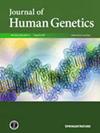Somatic and mosaic HRAS mutations in pediatric malignant ectomesenchymoma
IF 2.5
3区 生物学
Q2 GENETICS & HEREDITY
引用次数: 0
Abstract
Malignant ectomesenchymoma (ME), a rare tumor of soft tissues, has a neuroectodermal component of neuroblasts and/or ganglion cells, and a mesenchymal component mostly often represented by rhabdomyoblasts. Considering the peculiar and variable morphological structure of ectomesenchymomas, establishing the correct histological diagnosis can be challenging. The investigation presents 5 cases of ME, including 3 sporadic forms and 2 tumors in patients with neurocutaneous syndrome. Morphological and genetic tumor profiles were analyzed using immunohistochemical marker panel, coupled reverse transcription PCR and customized DNA-based NGS panel. The identified somatic variants were interpreted in accordance with the AMP/ASCO/CAP Guideline recommendations. In 4 out of 5 cases, mutations in HRAS typical for ME were detected. Two patients with HRAS mutation and phenotypic features of neurocutaneous epidermal nevus syndrome and nevus sebaceous syndrome had the pathogenic HRAS variant in a spectrum of biological materials including healthy tissues with different varying allele frequency (VAF). The molecular genetic findings indicate a post-zygotic origin of the pathogenic mutation in HRAS, associated with the mosaic phenotype, in both cases. Morphological and genetic profiles were analyzed in 5 pediatric cases of ME. The investigation revealed expression of neuroblastic and mesenchymal markers in corresponding components of the tumors. The majority of cases harbored HRAS gene variants in ME samples, 2 patients with neurocutaneous syndrome had the pathogenic HRAS variant with different VAF in various biological material including healthy tissues, that exposed the driver event as postzygotic, occurring not later than the stage of migrating ectomesenchyme originating from the neural crest. These are the first descriptions of ME against a somatic mosaicism background.

儿童恶性外阴间质瘤的体细胞和镶嵌型HRAS突变。
恶性外切间质瘤(ME)是一种罕见的软组织肿瘤,具有神经母细胞和/或神经节细胞的神经外胚层成分,以及以横纹肌母细胞为代表的间充质成分。考虑到外切间质瘤的特殊和多变的形态结构,建立正确的组织学诊断可能具有挑战性。本文报告5例ME,其中3例散发型,2例肿瘤伴神经皮肤综合征。使用免疫组织化学标记板、偶联反转录PCR和定制的基于dna的NGS板分析肿瘤的形态和遗传特征。鉴定出的体细胞变异按照AMP/ASCO/CAP指南的建议进行解释。在5例中有4例检测到ME典型的HRAS突变。2例HRAS突变患者的表型特征为神经皮肤表皮痣综合征和痣皮脂腺综合征,在包括不同等位基因变异频率(VAF)的健康组织在内的生物材料谱中存在致病性HRAS变异。分子遗传学结果表明,在这两种情况下,HRAS致病性突变的合子后起源与马赛克表型相关。分析5例小儿ME的形态学和遗传学特征。研究发现肿瘤相应成分中有神经母细胞和间充质标记物的表达。在ME样本中,大多数病例携带HRAS基因变异,2例神经皮肤综合征患者在包括健康组织在内的各种生物材料中都有不同VAF的致病性HRAS变异,这表明驱动事件发生在受精卵后,不迟于起源于神经嵴的外切间质迁移阶段。这些是针对体细胞镶嵌背景的ME的第一次描述。
本文章由计算机程序翻译,如有差异,请以英文原文为准。
求助全文
约1分钟内获得全文
求助全文
来源期刊

Journal of Human Genetics
生物-遗传学
CiteScore
7.20
自引率
0.00%
发文量
101
审稿时长
4-8 weeks
期刊介绍:
The Journal of Human Genetics is an international journal publishing articles on human genetics, including medical genetics and human genome analysis. It covers all aspects of human genetics, including molecular genetics, clinical genetics, behavioral genetics, immunogenetics, pharmacogenomics, population genetics, functional genomics, epigenetics, genetic counseling and gene therapy.
Articles on the following areas are especially welcome: genetic factors of monogenic and complex disorders, genome-wide association studies, genetic epidemiology, cancer genetics, personal genomics, genotype-phenotype relationships and genome diversity.
 求助内容:
求助内容: 应助结果提醒方式:
应助结果提醒方式:


